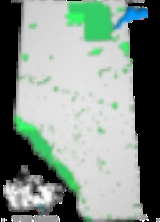
Caribou Mountains Wildland Park
Encyclopedia
Caribou Mountains Wildland Park is a large wilderness area in northern Alberta
, Canada
. It is located in the Caribou Mountains
, immediately west of Wood Buffalo National Park
in a remote backcountry area. The closest community in Alberta is Fort Vermilion
.
It was established by the Alberta Government in 2001 under the "Special Places program" by Order in Council 308/2001. At 5900 square kilometres (2,278 sq mi), it is the largest provincial protected area (the nearby Wood Buffalo National Park
is managed by the federal government).
that offers nesting grounds for a variety of bird species and core habitat of the threatened woodland caribou herd. A small number of wood buffalo is also present in the south-eastern part of the park. The Caribou Mountains reach an elevation of 1,030 m, almost 700 m higher than the surrounding area, and have a unique environment.
The park is located in the hydrographic basin of the Great Slave Lake
and that of the Peace River
. Yates River, Whitesand River, Buffalo River, Wentzel River, Wentzel Lake and Margaret Lake are found in the park area.
Alberta
Alberta is a province of Canada. It had an estimated population of 3.7 million in 2010 making it the most populous of Canada's three prairie provinces...
, Canada
Canada
Canada is a North American country consisting of ten provinces and three territories. Located in the northern part of the continent, it extends from the Atlantic Ocean in the east to the Pacific Ocean in the west, and northward into the Arctic Ocean...
. It is located in the Caribou Mountains
Caribou Mountains (Alberta)
The Caribou Mountains are a mountain range surrounding an elevated plateau in northern Alberta, Canada and which rise north of the lower Peace River, and are bounded to the north and east by the Wood Buffalo National Park....
, immediately west of Wood Buffalo National Park
Wood Buffalo National Park
Wood Buffalo National Park, located in northeastern Alberta and southern Northwest Territories, is the largest national park in Canada at . The park was established in 1922 to protect the world's largest herd of free roaming Wood Bison, currently estimated at more than 5,000...
in a remote backcountry area. The closest community in Alberta is Fort Vermilion
Fort Vermilion, Alberta
Fort Vermilion is a hamlet in northern Alberta, Canada within Mackenzie County.Established in 1788, Fort Vermilion shares the title of oldest European settlement in Alberta with Fort Chipewyan. Fort Vermilion contains many modern amenities to serve its inhabitants as well as the surrounding rural...
.
It was established by the Alberta Government in 2001 under the "Special Places program" by Order in Council 308/2001. At 5900 square kilometres (2,278 sq mi), it is the largest provincial protected area (the nearby Wood Buffalo National Park
Wood Buffalo National Park
Wood Buffalo National Park, located in northeastern Alberta and southern Northwest Territories, is the largest national park in Canada at . The park was established in 1922 to protect the world's largest herd of free roaming Wood Bison, currently estimated at more than 5,000...
is managed by the federal government).
Conservation
The park protects fragile wetlandWetland
A wetland is an area of land whose soil is saturated with water either permanently or seasonally. Wetlands are categorised by their characteristic vegetation, which is adapted to these unique soil conditions....
that offers nesting grounds for a variety of bird species and core habitat of the threatened woodland caribou herd. A small number of wood buffalo is also present in the south-eastern part of the park. The Caribou Mountains reach an elevation of 1,030 m, almost 700 m higher than the surrounding area, and have a unique environment.
The park is located in the hydrographic basin of the Great Slave Lake
Great Slave Lake
Great Slave Lake is the second-largest lake in the Northwest Territories of Canada , the deepest lake in North America at , and the ninth-largest lake in the world. It is long and wide. It covers an area of in the southern part of the territory. Its given volume ranges from to and up to ...
and that of the Peace River
Peace River (Canada)
The Peace River is a river in Canada that originates in the Rocky Mountains of northern British Columbia and flows to the northeast through northern Alberta. The Peace River flows into the Slave River, a tributary of the Mackenzie River. The Mackenzie is the 12th longest river in the world,...
. Yates River, Whitesand River, Buffalo River, Wentzel River, Wentzel Lake and Margaret Lake are found in the park area.
See also
- List of Alberta provincial parks
- List of Canadian provincial parks
- List of National Parks of Canada

